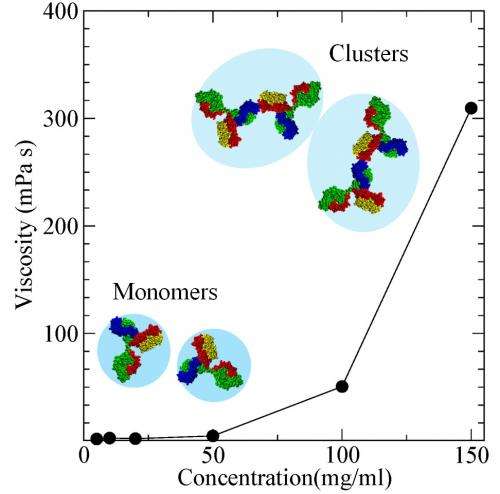Team helps cancer treatment drugs get past their sticking point

Potentially valuable drugs slowed down by sticky molecules may get another shot at success. Joint research by the National Institute of Standards and Technology (NIST), Genentech, the University of Delaware and Institut Laue-Langevin (ILL) has revealed the reason why a certain class of proteins tends to form clusters that lead to high viscosity in drug solutions.
The newly published results could help drug companies create a variety of cancer and autoimmune disease treatments based on monoclonal antibodies, whose stickiness can make them difficult to administer through thin needles.
Monoclonal antibodies (mAbs) are Y-shaped protein molecules that hold great promise for disease treatment. In principle, the tip region of two of their "arms" can be engineered to deliver attacks on tumor cells without harming surrounding tissue, making mAbs less dangerous to the body than standard chemotherapy, that kills both healthy and cancerous cells. However, a roadblock in the way of their bright pharmaceutical future as a subcutaneous injection—the preferred delivery technique—is their high viscosity: in solution, some mAbs become so viscous at required high concentrations that they are nearly impossible to inject.
MAbs with low enough viscosity can be injected, but pharmaceutical firms—which commonly spend billions of dollars to bring individual drugs to market—still don't know why some other mAbs stick together so tightly, meaning they can't be injected. So when Yun Liu of the NIST Center for Neutron Research (NCNR) published results in 2010 about why some globular proteins form clusters in solution, he attracted the attention of Genentech, a company that already had mAb-based drugs on the market.
"With the neutron beams at the NCNR, we essentially can take a picture of protein motions at a timescale of less than half a microsecond, which is fast enough to see how they change their orientations and move together in solution," Liu says. "When you put these mAbs in water, they twist around and stick to one another. We wanted to explore the fundamentals of viscosity by understanding the molecular structure as it develops, so we can model it better."
Genentech scientists had learned a few things about their mAbs already: Adding salt to the solution reduced its viscosity, for example. But using the neutron spin echo instruments at NCNR and ILL, Liu and scientists from several institutions found out something more fundamental. In the high concentrations needed in drug solutions, these mAbs partner up, forming very strongly bounded clusters made primarily of two protein molecules at a time, with an arm from one molecule linked by electrical attraction to a different arm on another.
"We believe that this is a key insight that explains the company's findings, as well as the behavior of possibly some other mAbs," Liu says. "Knowing that much will allow us to model these protein clusters, so we can do simulations about their behavior based on their sequence. It offers a guide for drug companies to formulate similar types of proteins in the future."
The operation of the neutron spin echo instrument at NIST is funded in part by the National Science Foundation.
More information: E.J. Yearley, P.D. Godfrin, T. Perevozchikova, H. Zhang, P. Falus, L. Porcar, M. Nagao, J.E. Curtis, P. Gawande, R. Taing, I.E. Zarraga, N.J. Wagner and Y. Liu. "Observation of small cluster formation in concentrated monoclonal antibody solutions and its implications to solution viscosity." Biophysical Journal, DOI: 10.1016/j.bpj.2014.02.036, April 16, 2014.
Journal information: Biophysical Journal
Provided by National Institute of Standards and Technology

















